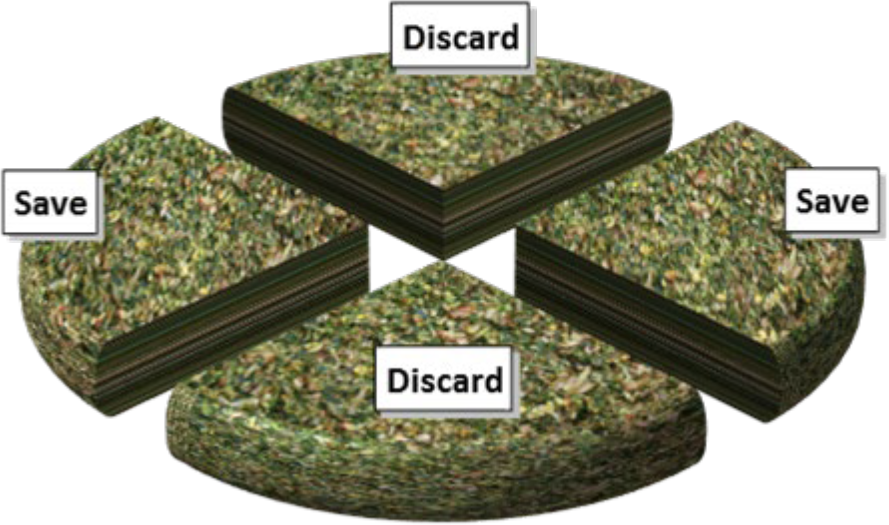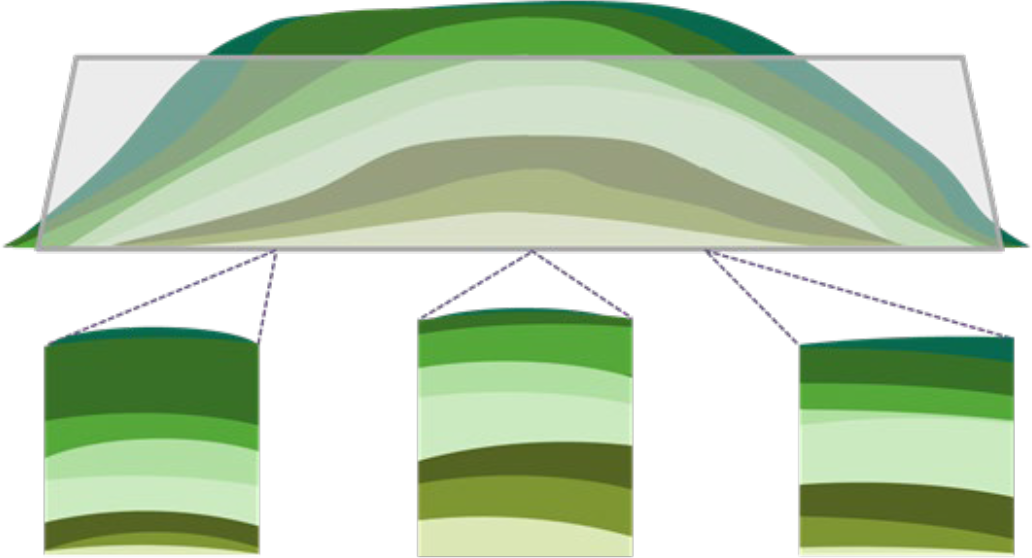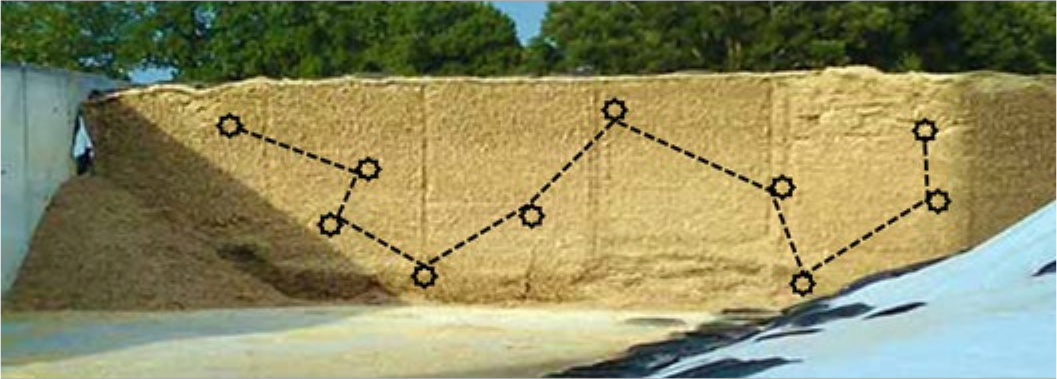⇦ Back to Livestock and Feedstuff Management Home
¶ Introduction
Different varieties, harvest times, or storage conditions cause variations in silage quality. We use laboratory testing to identify these differences and balance rations properly. Representative feed samples are essential to get accurate laboratory results. These procedures are recommended to help obtain those representative samples.
¶ Represent the “Lot” of Silage
A “lot” of forage consists of the forage from a uniform set of conditions, e.g., harvested from one field at the same cutting and maturity. Silage from the same “lot” should be produced from the same crop or crop mixture, similar maturity and harvest date, same additives, curing and storage conditions, and other characteristics.
The forage value can be substantially different if there is variation in any of these characteristics. Designate a new “lot” of silage when these characteristics change.
¶ General Guidelines
Silage can be sampled anytime, before it goes into the silo or when it is fed. Silage is best sampled after the ensiling (fermentation) process is complete. Because of variability, individual fields should be sampled separately.
Collect two to three gallons of small samples (hand-grab or subsamples) to create a composited and representative bulk sample. Then “quarter” the bulk sample to save about one to two quarts of sample for analysis (see Figure 1). Pack sample tightly in a plastic bag, squeeze to exclude air, and seal. Refer to Crop File 6.01.001, “Feed and Forage Sampling – General Guidelines” for details on the “quartering” procedure.
Avoid rotted silage or poorly preserved silage that will not be fed or will not be consumed if fed. This type of material comes from the top or exposed surfaces or from the shallow end and slopes of horizontal storage.
If non-protein nitrogen has been added, sample two to four weeks before feeding.
¶ Figure 1. Separate Sample Into Quarters; Save Two, Discard Two to Reduce Sample Size

¶ Sampling During Harvest (Fresh or Greenchop)
Collect random handfuls of chopped material from the cutter, silo blower, or from several locations in the wagon or truck. Sample several times during the day and composite these sub-samples for analysis.
Collect four to five handfuls from a single load because distribution of stems, leaves, or grain is not uniform throughout the load. Leaves tend to gather on the sides and the back of the chopper wagon and stems tend to bunch at the center of the wagon.
The sample should consist of two to three gallons of plant material. Use the quartering procedure to reduce the bulk sample size to fit in a one to two quart zipper-lock plastic bag.
Quality should not change much from harvest time to feeding time, if the silage has been packed and stored properly. Resample the silage if it has heated or you notice seepage.
If silage has heated, it may have a dark brown color with a sweet or “tobacco” type of odor, rather than the normal fermented silage odor. Collect a sample from the silo if the silage has this appearance and have it analyzed for “heat damaged protein”.
If seepage from the silo has occurred, collect a sample for analysis even if the silage has been previously analyzed. Seepage indicates that protein and carbohydrates may have been lost, affecting the silage nutritional value.
¶ Horizontal Silage Storage (Pit, Bunker, Pile)
Silage is often harvested from different fields or weather conditions, depending on the time required for harvest. The composition of the silage in the storage structure is not necessarily uniform. There are likely to be layers of silage with variable quality from different fields or different growing conditions (see Figure 2).
These stratified layers can develop as the loads of silage are successively deposited and packed during the harvest period. The earliest harvested silage is found on the bottom and the last silage harvested is found on the top of the storage.
The depth and orientation of these stratified layers may be different in different areas of the silo. The average quality of the silage may change as the storage is emptied from front to back.
It is important to collect enough subsamples for the composite to minimize variability within the bulk sample. Collecting too few subsamples may allow one of the stratified layers to dominate the bulk sample and bias the final laboratory analysis.
If the silo has not been opened and has a plastic covering, dig a series of four to six holes from the top with a posthole auger or suitable equipment. Remove spoiled silage prior to taking the sample.
Mix the subsamples together to prepare a representative bulk sample. Sample holes need to be repacked with the silage that had been removed and the plastic resealed to prevent spoilage.
After the pile has been opened, one option is to collect 20 or more hand-grab samples from the exposed face of the silo to represent the entire exposed surface. Collect samples in a randomized “W” pattern across the face of the exposed silage (see Figure 3).
Collect the hand-grab samples by using an upward motion with the palm up and fingers extended to prevent loss of fines. Do not shake or squeeze the subsamples, but transfer them immediately into the bucket used to hold the bulk sample.
NOTE: For safety reasons, it may be more prudent to use a loader bucket or face shaver, carefully scrape across the face – either vertically or horizontally depending on how you are feeding – into a pile on the silo floor.
Do not scrape spoiled material from the top of the silo into this pile. Collect about two to three gallons of handfuls from this pile on the floor as a composite bulk sample. “Quarter” the bulk sample to reduce sample size for submission to the laboratory.
¶ Figure 2. Example of Stratified Layers Inside Horizontal Silage Storage From Harvested Silage of Different Qualities

¶ Figure 3. Sampling Pattern for Horizontal Silage Storage

¶ Upright Silos (Tower-Type)
Do not sample until about 2 to 3 feet of silage has been removed from the top. Collect 15 to 20 random handfuls of silage from the unloader during the feeding period. Mix the bulk sample thoroughly and “quarter” to reduce sample size.
Silage composition changes with the fermentation process as the silage remains in the silo for extended periods. The silo should be sampled more than once during the feeding period, especially when more than one field or more than one kind of forage is stored in the silo.
If the silage is being fed out quickly, collect samples whenever each 20 to 25 percent of the contents are removed. If it being fed more slowly, it is advisable to collect samples every four to six weeks of the feeding period.
¶ Silo Bags
There are two options for collecting samples from silo bags.
- Collect six to eight hand-grab samples from different locations across the silage face. After silage has been removed, collect a second set of hand-grab samples from the newly exposed face.
- Collect 8 to 10 core samples through the sides of the tube at various distances along the length. Collect two handgrab samples at each location. Composite the hand-grab samples and quarter to reduce sample size.
Sample holes need to be repacked with the silage that had been removed. Repair holes made in the plastic to prevent spoilage. Composite the hand-grab samples and quarter to reduce sample size.
¶ Total Mixed Rations (TMR)
There are four main reasons for analyzing a total mixed ration:
- to compare the calculated ration to the fed ration,
- to check if the TMR is properly mixed,
- to see if animals are sorting through or selecting their food, or
- to know more about an unknown ration
Mix the TMR using normal procedures and distribute in the bunk as normal. Sample the TMR immediately after distribution into the bunk line.
Unlike sampling individual feed ingredients, which can be sampled at any time, a TMR must be sampled within about five (5) minutes after delivery. Animals begin to sort feed ingredients immediately after feed delivery and can alter the composition of the TMR sample that is being collected.
Collect hand-grab samples at ten (10) intervals along the entire bunk line. The intervals should be evenly spaced along the line of sampling. Collect samples from the top, middle, and bottom of the ration in the bunk at each interval.
Do not squeeze or shake the hand-grab samples before placing them in the sampling bucket.
Another option is to place plastic sheets (like trash bags) or buckets along the bunk line before the feed is delivered. Then remove the sheets or buckets and composite the TMR that has been captured into the bulk sample.
Do not avoid oversized feedstuffs or large by-product feed ingredients during sampling. Clip long forages (such as straws or grass hays) that do not break up during mixing to a length of about one to two inches to avoid over-representing them in the final sample.
The sample bucket should contain two to three gallons of TMR when all of the hand-grab subsamples have been collected. Mix the bulk sample thoroughly and quarter to reduce it to the final sample volume of about one to two quarts.
If sorting by the animals is a concern, compare the particle size distribution of the fresh TMR to that of the refused feed. This may explain discrepancies in the TMR analysis, especially if samples are not collected soon after feeding.
¶ Pre-harvest Standing Forage
Sampling standing forage before harvest will help to determine if a field is ready to cut for hay or silage. Select sampling sites (clipping sites) randomly throughout the field to provide a representative sample. Walk in an “M” or “W” pattern throughout the field.
Clip and remove samples at harvest height at 8 to 10 regularly spaced locations. For a small field, this might mean every 20 steps, for a large field this might mean every 50 steps. Sample number should be increased for larger fields in order to obtain a better average.
Chop the collected forage into pieces 2 to 3 inches long. Mix thoroughly and place about one quart of sample in a plastic bag and ship immediately to the laboratory.
¶ Pasture
Collecting samples from standing forage can help determine if any supplemental feed is required during grazing. Obtaining a representative sample from pastures is difficult because of variability in soil fertility, moisture, plant growth stage, and variation in plant types present.
In evenly grazed pastures, collect samples by establishing a grid plan. Collect the forage from a one-square foot area in 5 to 10 predetermined grid points, based on pasture size.
If there are large variations within the field, because of proximity to a water source running through or a hillside, collect multiple samples to best represent the variations within the pasture.
Chop the collected forage into pieces 2 to 3 inches long. Mix thoroughly and place about one quart of sample in a plastic bag and ship immediately to the laboratory.
¶ References
Anderson, Mader, & Kononoff. 2007. Sampling Feeds for Analysis. Pub. G331. Univ. of Nebraska Coop. Ext. Serv., Lincoln NE. 2 pg.
Glunk, Van Emon, & Malisani. 2016. Collecting a forage or feed sample for analysis. Pub MT201610AG. Montana State Univ. Extension, Bozeman MT. 4 pg.
Robinson, & Meyer. 2010. Total mixed ration (TMR) sampling protocol. Pub. 8413. Univ. of California, Dept. of Agric. & Nat. Res., Davis CA. 5 pg.
Undersander, et. al. 2005. Sampling hay, silage, and total mixed rations for analysis. A2309. Univ. of Wisconsin Coop. Ext. Serv., Madison WI. 8 pg